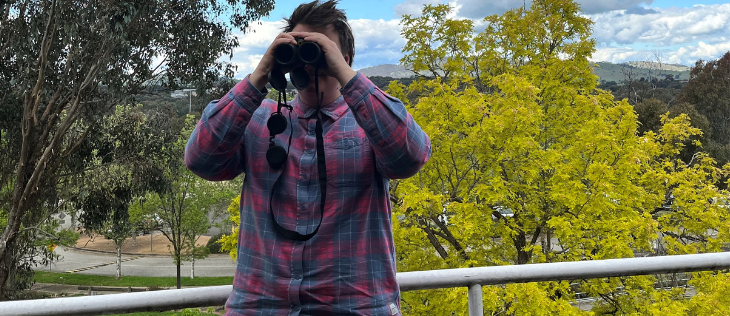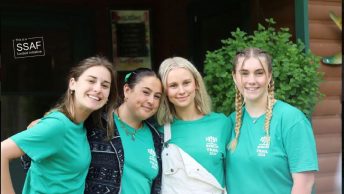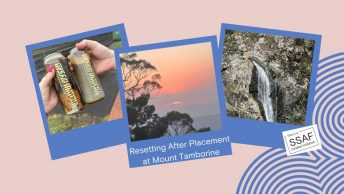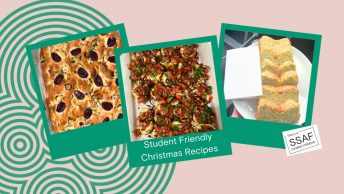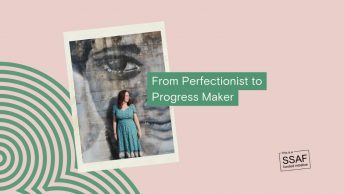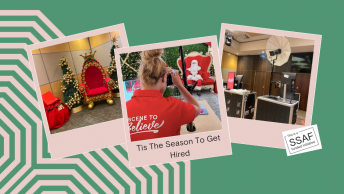This post is over three years old, the information may be outdated.
Written by Faith Hanstock
For over a decade photographer and journalist, Brandon Stanton, has given a worldwide audience a “daily glimpse into the lives of strangers on the streets of New York City” with Humans of New York.
Inspired by Brandon’s storytelling success, we bring you ‘Humans of Charles Sturt’.
Erika, what do you do here at Charles Sturt?
“I’m a Student Advocate in the Division of Safety, Security, and Well-being. We help and support students with navigating the rules, policies, and procedures at Charles Sturt.
The main things we provide guidance to students on is responding to allegations of academic or general misconduct and appealing university decisions. We also provide assistance with applications for things like special consideration, review of grades, and academic progress matters.”
What encouraged you to start working as a Student Advocate?
“I’ve got a background in environmental science and came to the Albury Charles Sturt campus to do postgraduate study. After doing some sessional lecturing, I realised that I have a big passion for supporting and working with students to achieve their study goals. I started working with the outreach and academic skills teams to help students build their study skills, and then a great opportunity came up as a Student Advocate. I was keen to use my previous experience in lecturing and working with students to help them navigate tricky situations when they’re at uni.”
So, you work on the Albury campus – what is it that you love most about working there?
“Environmental science and a love for nature is what essentially brought me out here, and one of the things I like most about our campus is the natural environment. We’ve got beautiful wetlands, wonderful trees and vegetation, lots of wildlife, and lots of birds, which is really exciting! We’re a small campus as well, so you get to know students and colleagues, which makes it a great place to work.”
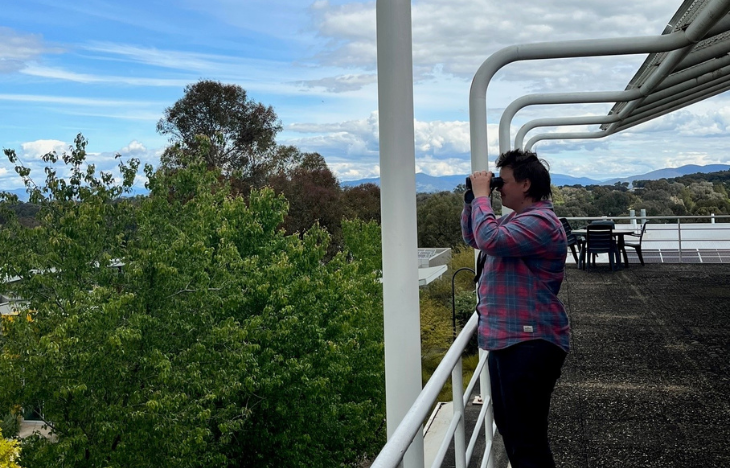
What got you into bird watching?
“I am fairly new to bird watching, but have always been around people who are into birds. I started my environmental science journey as an undergraduate student in 2005, through this I’ve got lots of friends who are into birds, and some even get study birds as their job! I never really picked it up until recently. BirdLife Australia does a national bird count every year, and since last year’s bird count and as an activity during lockdowns, I have become a pretty keen bird noticer.”
What is BirdLife and the Aussie Bird Count?
“BirdLife Australia is a not for profit organisation dedicated to protecting native birds and their habitats, they do some really important work across Australia.
The annual Aussie Bird Count started on Monday and is happening all over Australia until Sunday. It’s part of National Bird Week and is a really big citizen science project where people spend 20 minutes outside identifying and counting the different birds they see. The observations help BirdLife track how Australia’s birds are doing and inform conservation efforts for birds and their habitats.
There’s a great website and app that people can use to identify and count the birds they see. You provide information about the bird you’re seeing such as colour, size, and shape and it narrows it down to birds in your area so you can identify them. You can also look on a map to see what birds people around you have found in their counts. I usually try and do a couple of surveys every day during the count, one in the morning and one in the evening.”
Are you involved in any bird watching organisations or local community groups?
“In Albury, there are a lots of organisations and groups that can help people get started with bird watching, learning about birds, or contributing to the conservation of birds. Although I’m not super active in them, I do like to follow along on social media. There are also local bird watching Facebook groups where birdwatchers can post observations and pictures of the species they found.”
What are some other apps you can use to help with bird watching?
“I use the BirdLife app as I mentioned before, but you can also use eBird and contribute to other citizen science projects like NatureMapr or iNaturalist. I also use Youtube to listen to bird calls, so I have a general idea of what I’m listening out for.
Another really good app is kind of like a Shazam for birds, it’s called BirdNET. This app listens to the calls and sounds the birds are making and provides you with a guess about the birds you can hear based on your location. Using a combination of visual and audio tools helps with knowing what birds look like and sound like, so then when I pull my binoculars out, I have a better idea of who I’m looking at.”

What skills are involved in bird watching?
“Usually, it depends on what level of involvement you want to get into. For me, I consider this to be a hobby, I am an amateur bird watcher. As I learn, my skills are growing over time. I am still learning the language of birds and figuring out how to identify them. One skill I have recently learned is how to use binoculars properly to get a good look at birds from a distance. Binoculars are a a great tool and I found learning how to use them to be a real learning curve because I hadn’t really used them before. The more and more familiar I get, the more I learn, meaning it becomes easier for me to identify and learn about birds in my area.”
Do you set any goals within this hobby?
“When I go away to a new location, I like to set myself some goals. I recently went on a camping trip to a local wetland and my goal was just to learn two new birds including what they looked and sounded like. I was able to do it! Now that I know these two, next time I go away I can learn another two birds and continuously build upon that knowledge.”

What has been the hardest part about learning to bird watch?
“The hardest thing to learn has been getting used to the language of birds. My background is in plants and I’m fairly good at being able to identify plants because I know what words describe which parts of the plant that I’m looking at. However, with birds, I’ve had to learn a whole new language of what parts of the bird I’m looking at to enable me to identify what bird it is.”
Does Charles Sturt offer any bird watching subjects?
“We deliver Ornithology courses here at Charles Sturt and we have some amazing bird experts on staff who are doing world-class research on birds in Australia and internationally. Although for me, bird watching is more of a hobby more than a career path. But it’s definitely a career that people can do, and the idea of getting paid to watch birds, is pretty cool!”
What are your favourite spots to bird watch?
“One of my favourite spots to bird watch is through my office window. I’m on the fifth floor of the building, so I’m right up in the canopy where I can see all different species flying around.
Like I said before, the Albury campus has a lovely natural environment and outside my window there are flowering eucalypts that are just buzzing with birds at the moment. The nectar in the flowers and insects that live on the leaves are an important food source for lots of birds. Being able to see that from my window is one of my favourite things – connecting with nature is a mindfulness activity for me that makes my workday that bit more enjoyable.”

Best thing you’ve seen at Wonga Wetlands in Albury?
“Last time I was out at Wonga Wetlands, I saw a funny duck called the Musk Duck. When I was there, I saw one trying to impress a mate by kicking and splashing water behind itself , inflating a lobe in its neck, basically doing a little courtship a dance. Definitely a highlight for me from a really interesting species of duck!”
What are some of the species of bird that you’ve been excited to see?
“We’re really lucky on the Albury campus, I’ve seen threatened parrots outside my office window that have travelled a really long way from Tassie to feast in the eucalyptus I mentioned before. This was pretty special. I’ve also been really lucky to see a little bird called the Plains Wanderer, which is a threatened species that lives in the grasslands.”

What’s your favourite thing about National Bird Week?
“I really love that so many people get involved and seeing the birds that other people in my area are seeing in their counts. You feel part of a community and part of something bigger that’s making a big contribution to understanding and conserving Australian birds.”
Are there any bird influencers that have taken you under their wing?
“I don’t really have a specific person I am influenced by, because I know a lot of people that are into birds. I do have a good friend who did give me some lessons on how to use binoculars and things like that, and she also helped me understand how to listen to bird calls, etc. Overall, lots of my friends and colleagues are really into birds, so there isn’t someone I am specifically influenced by.”
Are there any last comments you would like to make?
“Thank you for the opportunity to talk about birds, if anyone has any questions or if you’re keen to get into bird watching now is a great time to start! Check out BirdLife Australia, do some counts and download some of the apps mentioned here. It’s a supportive and encouraging community!
To me, bird watching has been really important for my well-being, mindfulness, mental health, positivity, and getting me out in nature. Despite all the rain we’ve had at the moment, it’s Spring and it’s a really great time to get out and connect with nature.”


